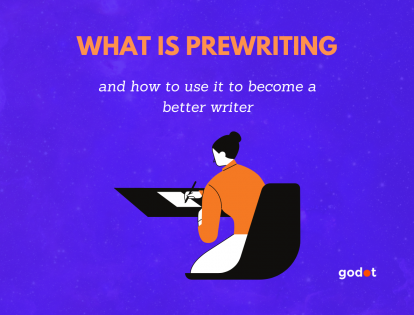When you first learn how to write content, you may get overwhelmed with where to start and what to write. It’s not always easy to begin your first step as a writer if you have no supporting background on it.
Every skilled occupation needs hours of training to be called an expert. In writing too, it takes days of practice and a few mistakes for you to identify your writing niches.
Yes, you need time to practice and hone your writing skills. This is where prewriting comes in.
What is prewriting?
Prewriting is generally a step before you start writing anything, that includes brainstorming ideas, noting down key points, and outlining your draft. It is a critical process where you can delve more into an in-depth structure of your content that results in stellar writing.
Normally, writers will make several bullets consisting of ideas they are going to write. But, most beginners will just write down without having a concept for their pieces which often leads to generic and tedious articles.
While experienced writers can do just fine, even though many will stick to outlining at the very least, straightaway writing your posts isn’t recommended if you’re new to this field.
Prewriting helps you get your creative thinking on, prepare for the writing process, and recharge your creative juices.
The purpose of prewriting in improving your skills
There are three main purposes of prewriting:
- To figure out a plan of work: With prewriting, you can get a glimpse of what you’re going to write, and that helps you plan out your work.
- To develop ideas: Then, you can brainstorm and get a general idea of what you need to write about.
- To power up your content marketing writing: If you’re writing for marketing purposes, prewriting allows you to create writing strategies that improve brand awareness and increase traffic.
Prewriting helps minimize errors that may happen during the writing process and in the end results, such as plot holes if you’re writing fiction. You may as well have a better understanding of your writing because you’ve seen the bigger picture of it.
5 prewriting strategies you can implement
Think of your pre-writing plan as a ‘to-do’ list before writing a piece. You can start with ideas, tasks, and items that you’re interested in. Or, you may explore the ideas to have detailed information to pour into your writing.
In case you have no time to write immediately, prewriting helps store your ideas and plots to catch up later on.
Here are 5 strategies you can implement for an effective prewriting stage.
1. Brainstorming
Brainstorming is the process of generating ideas that are overflowing in your head. When you think of something, it can lead to a topic cluster that branches to many possibilities.
Your job is to take note of what ideas catch your interest the most, what content strategy gives the most potential outcomes, etc. Make sure to generate as many ideas as possible and note them down to review them later.
2. Freewriting
Freewriting is the act of writing writing whatever comes to your mind immediately as notes. You can freely write as much or as little as you choose. A great way to start is by writing nonstop about your ideas without thinking of any grammar errors.
This exercise helps you create a creative and impulsive type of content as the idea flows.
3. Clustering
Clustering or mind-mapping is when you put ideas into visual elements, such as diagrams. If you’re writing an article, you can use it as a way to organize your thoughts. So, you know where the idea will go through in your article.
On the other hand, if you’re brainstorming, you can use this method to connect thoughts and ideas. That way, any cluttered ideas can be easily selected or removed by creating a mind map that’s easy to understand. For a more practical approach to organizing your insights, consider easily creating a flowchart in Word. This provides an additional visual tool to depict relationships and enhance the overall structure of your document.
4. Journalist questioning
Journalist questioning is a common way to start writing. You can use this strategy more effectively when you’re working on an in-depth project. Use initial questions such as:
- Who?
- What?
- When?
- Where?
- Why?
- How?
Ask yourself this question starting from: “What is?” to find out more about the topic you write. If you can come up with an honest, yet insightful, answer, then you will have a much better chance of getting the full, rounded, and enjoyable writing process you’re looking for.
5. Outlining
Lastly, outlining is the process of creating a structure and following through with all of the necessary tasks required for it. Outlining helps you write on track and stick to the topic.
Many writers are lost in stuffing unnecessary information that doesn’t help explain the idea because they don’t have an outline to follow. This is why outlining makes a great way to help you focus on what you’re trying to say, and it can also be an excellent method to help you get through the writing process without getting overwhelmed.
Takeaway
The writing process doesn’t instantly start with you creating a draft in your documents. A good writer knows that prewriting helps them through the process by giving a little heads up.
It’s important to schedule a time for your prewriting session. You can take papers, notebooks, or even as little as post-it notes to pour your ideas once they come to mind. Make sure to simplify ideas and use easy sentences so you’ll understand them later when you start writing.
Author: Adela Belin is a content marketer and blogger at Writers Per Hour. She is passionate about sharing stories with the hope to make a difference in people’s lives and contribute to their personal and professional growth. Find her on Twitter and LinkedIn.
